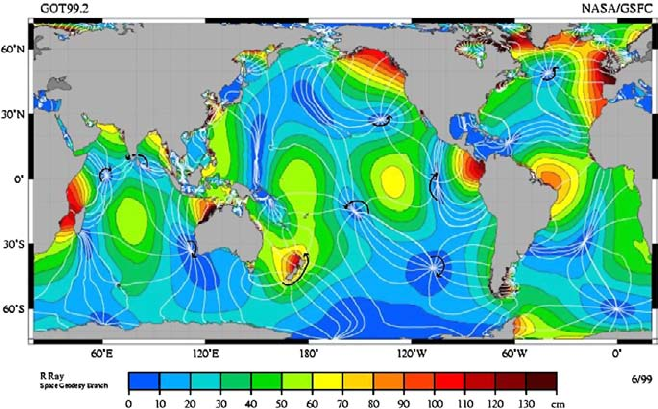Fowler A. Mathematical Geoscience
Подождите немного. Документ загружается.


200 3 Oceans and Atmospheres
six hours). At the poles the tides are in phase. In-phase tides are called direct, and
out-of-phase tides are called indirect. At a latitude of cos
−1
(1/S) ≈65
◦
, resonance
occurs and tides can be significantly higher than the peak equilibrium tide of about
0.4 m.
Ocean Basins
In reality, there are continents, and these act as boundaries to the oceanic tidal flow.
The free canal tidal wave given by (3.278) is a particular solution of the forced wave
equation (3.271), but in an ocean basin, or in a canal with ends, free waves of the
system are excited in order to prevent overflow at the ends. A solution for the case
of a narrow canal at latitude λ with ends at longitude φ =±
L
2
is easily found with
the same method as above, except that we allow the solution to depend on t and φ
independently. We find η =χ +f(φ,t), and the integrability condition for f takes
the form
cos
2
λf
tt
−f
φφ
=4S
2
cos
2
λχ, (3.279)
and solving this subject to f
φ
= 0atφ =±
L
2
, we finally obtain the solution (see
also Question 3.11)
η =
cos
2
δ cos
2
λ
1 −S
2
cos
2
λ
[A cos 2St +B sin 2St], (3.280)
where
A =cos2φ −
S cos λ sin L cos(2Sφ cos λ)
sin(LS cos λ)
,
B =−sin 2φ +
S cos λ cos L sin(2Sφ cos λ)
cos(LS cos λ)
.
(3.281)
The first terms in the expressions for A and B represent the forced tidal wave, and
the second terms represent the free oscillations in the basin at the same frequency.
We see that resonance occurs if S cos λ =1, as before, or if
2LS cos λ =nπ, (3.282)
for integral n.
3.11.3 Seiches
A particular example of the tidal oscillations which occur in closed basins is af-
forded by the waves observed in lakes, termed seiches. For these, rotational effects
are indeed small, and the relevant value of L is also. In addition, the depth of lakes
is much less than that of the ocean, so that the tidal forcing coefficient S is larger.

3.11 Tides and Tsunamis 201
For example, for a lake of length 80 km and depth 100 m, we have L ∼ 0.02 and
S ∼15. Supposing the lake to be narrow and aligned with φ, we write
φ =φ
0
+
ξ
L
, (3.283)
and then (3.281) is approximately (for L 1)
A =cos2φ −
Λ cos 2Λξ
sin Λ
,
B =−sin 2φ +
1
L
Λ sin 2Λξ
cosΛ
,
(3.284)
where
Λ =LS cos λ. (3.285)
The dominant coefficient is B, since Λ can be a good deal larger than L. With the
lake dimensions above, at λ =
π
4
, Λ ≈0.2. After some algebra and approximation,
we find the tide given by (3.280) to be approximately
η ≈
cos
2
δ
S
sin 2Λξ sin 2St, (3.286)
giving a standing wave of fairly small amplitude. The decrease of depth at the lake
margins can enhance the amplitude considerably.
3.11.4 Amphidromic Points
The solution above in (3.280) for a canal represents the superposition of the forced
westward travelling wave with two waves (bound by the basin) having the natural
speed of the oceans (which is one, in these dimensionless units). When resonance
occurs, this canal solution takes on the form of a standing wave.
Suppose, for example, that
LS cos λ ≈
π
2
; (3.287)
then the dominant part of the solution in (3.280) can be written as
η ≈−
π cos L
L(2LS cos λ −π)
sin
πφ
L
sin 2St, (3.288)
and is a standing wave; in particular, there is a nodal point at φ = 0 where η ≈ 0:
at that point there is approximately no tide. If we consider the dominant part of the

202 3 Oceans and Atmospheres
coefficient A in (3.281), then we find that it is generally non-zero at the resonant
canal length; however, if we choose
2L ≈π sin L (3.289)
as well as (3.282), then there is a genuine nodal point.
27
In our discussion so far, we have neglected Coriolis force and the sphericity of
the Earth. It is really not sensible to do this, since tidal forcing gives fundamentally
two-dimensional motion, but the simpler analysis does illuminate two ideas, which
turn out to be central in understanding how the tides work. The first is the idea of the
tide as a wave, and the second is the idea that there can be nodal points. These two
features essentially describe the real tide. The nodal points where the tidal amplitude
vanishes are called amphidromic points.
We go back to the linearised model (3.269), again taking h =1. It is clear that
tidally forced solutions will be periodic, and we therefore write
χ = Re
cos
2
δGe
2iSt
,
η =Re
cos
2
δNe
2iSt
, (3.290)
u =Re
cos
2
δ Ue
2iSt
,
where we define
G =e
2iφ
cos
2
λ. (3.291)
We substitute these into (3.269), and can then determine U by taking the cross prod-
uct of (3.269)
2
with k, and this yields
U =
i∇ψ −sin λ k ×∇ψ
2S cos
2
λ
, (3.292)
where we define
ψ =N −G. (3.293)
It follows from this that ψ satisfies
∇.
∇ψ +i sin λ k ×∇ψ
cos
2
λ
+4S
2
ψ =−4S
2
G. (3.294)
The boundary conditions on the ocean-continent boundary are taken to be U.n =0,
and if we let n denote the outward normal away from continents, and t the tan-
gent vector at the continent when its boundary is traversed counter-clockwise, then
k ×n =t, and the no-flow-through boundary condition can be written
∂ψ
∂n
−i sin λ
∂ψ
∂t
=0on∂C, (3.295)
27
Thus L =
π
2
, and using (3.287), S cos λ =1.

3.11 Tides and Tsunamis 203
where ∂C denotes the continental boundary. In spherical coordinate form, the
Helmholtz type equation (3.294) can be written, after some manipulation, in the
form
1
(1 −μ
2
)
2
∂
2
ψ
∂φ
2
+
∂
2
ψ
∂μ
2
+i
1 +μ
2
(1 −μ
2
)
2
∂ψ
∂φ
+4S
2
ψ =−4S
2
G, (3.296)
where we define
μ =sin λ. (3.297)
(3.296) looks a little strange with the imaginary term, but in fact the equation
behaves essentially as a Helmholtz equation. Both the tidally forced (particular)
solution and the free (homogeneous) solutions have separable forms
ψ =Ψ(μ)e
iαφ
, (3.298)
where
Ψ
+
4S
2
−
α(α +1 +μ
2
)
(1 −μ
2
)
2
Ψ =0, (3.299)
though such solutions have limited applicability in a realistic geometry.
They do, however, point the way to understanding the solution behaviour which is
actually observed. For sufficiently small longitudinal wave number α, Ψ will also be
oscillatory, and the resulting waves are essentially Poincaré or gravity waves, which
we have seen before in the atmosphere (in Sect. 3.4). For large α, Ψ is exponential,
and the resultant waves are edge waves, attached to coastal boundaries, and are
Kelvin waves. In the open ocean, an oscillatory solution of the form
N ∝exp
−i(αφ +βλ)
(3.300)
corresponds to a tidal wave moving in the direction (α, β), and this is the form of
the solution locally providing N = 0.
More generally, suppose the solution ψ of (3.296) with (3.295) is computed, and
thus N is determined. We define the amplitude R
CR
(φ, λ) and the phase t
CT
(φ, λ)
by
N =R
CR
exp(−2iSt
CT
). (3.301)
Then the surface elevation η is given by
η =cos
2
δR
CR
(φ, λ) cos
2S
t −t
CT
(φ, λ)
. (3.302)
The lines t
CT
(φ, λ) = constant are called co-tidal lines; they represent the crest of
the tidal wave as it circulates round the world’s oceans. The quantity R
CR
is called
the co-range. It is a measure of the tidal amplitude at a point.
28
If N was an ana-
28
In practice, the co-tidal phase and co-range amplitude are dimensional quantities; the phase is
measured in hours (of the lunar day), while the co-range is the elevation distance between high and
low water, and thus twice the amplitude of the underlying sine wave.

204 3 Oceans and Atmospheres
lytic function (i.e., ∇
2
N =0), then the co-tidal phase lines and co-range amplitude
lines would be orthogonal. This is not the case in practice, but they do intersect
transversely, and thus retain much of the same topology.
The image of a global tidal wave washing round the oceans breaks down at points
where N =0, since then the solution can no longer be approximately exponential as
in (3.300). Because N is complex, the condition N =0 requires both Re N(φ,λ)=
0 and ImN(φ,λ) =0, and thus occurs at isolated points: these are the amphidromic
points. In their vicinity, N varies linearly with φ and λ, and the local structure may
be recovered by consideration of (3.296) when N ≈ 0, i.e., ψ ≈−G:ifN = 0at
(φ
0
,μ
0
), then we put
φ =φ
0
+X, μ =μ
0
+aY, (3.303)
where we will choose a>0 later for convenience. For small X and Y ,(3.296)
implies, approximately,
1
(1 −μ
2
0
)
2
∂
2
ψ
∂X
2
+
1
a
2
∂
2
ψ
∂Y
2
+i
1 +μ
2
0
(1 −μ
2
0
)
2
∂ψ
∂X
≈0, (3.304)
and this has local solutions of the form
ψ =−G
0
exp[iαX +βY], (3.305)
where G =G
0
at the amphidromic point, and
β =±
a
(1 −μ
2
0
)
α
2
+
1 +μ
2
0
α
1/2
. (3.306)
Note that if solutions are oscillatory in the φ direction, then they are locally expo-
nential in the λ direction, providing α>0orα<−(1 +μ
2
0
).
In the vicinity of the amphidromic point,
G ≈G
0
exp
2iX −
2μ
0
aY
1 −μ
2
0
, (3.307)
and thus
N ≈ G
0
exp
2iX −
2μ
0
aY
1 −μ
2
0
−exp{iαX +βY}
≈ i(2 −α)G
0
[X +iγY], (3.308)
where
γ =
a[2μ
0
±{α
2
+(1 +μ
2
0
)α}
1/2
]
(1 −μ
2
0
)(2 −α)
. (3.309)
By choosing a appropriately, we therefore have the local structure
N ∼(X ±iY) (3.310)

3.11 Tides and Tsunamis 205
Fig. 3.13 Co-tidal map of the M
2
tide, deduced from Topex/Poseidon satellite altimeter measure-
ments. The colour scale indicates the amplitude of this component of the tide. White phase lines
are shown every 30°, with the heavier lines representing 0° (corresponding to when the mean moon
passes the 0° or 180° meridians). Figure courtesy of Richard Ray, NASA Goddard Space Flight
Center, and kindly provided by Helen Johnson
if β is real. In local polar coordinates X +iY =Re
iθ
, we then have
R
CR
∼R, 2St
CT
=∓θ, (3.311)
and this gives the local structure of the co-tidal lines and co-range lines in the vicin-
ity of an amphidromic point. The co-tidal lines fan out from the point, forming a
web whose circular strands are the co-range lines. At the amphidromic point the
tidal range is zero, and in its vicinity the tidal wave spins round as if glued to the
amphidromic point. The rotation is anti-clockwise if the plus sign is selected in
(3.311), and clockwise for the minus sign. Generally rotation is anti-clockwise in
the northern hemisphere and clockwise in the southern hemisphere, but not always.
Figure 3.13 shows a map of the co-tidal lines for the world oceans. The rôle of the
amphidromic points in organising the global tidal wave is clear.
If we supposed that −(1 + μ
2
0
)<α<0, then β would be imaginary, and the
value of γ is complex, but as long as the real part is non-zero, the conclusion is
essentially unaltered.
3.11.5 Tsunamis
We have not discussed the effect of shallowing of the ocean on the continental slope
which joins the continental shelf to the abyssal ocean bottom. It is fairly evident,

206 3 Oceans and Atmospheres
simply through conservation of mass, that a wave will increase in height as the
depth decreases, but for tidal waves, the wavelength is usually so large that this is of
little relevance. This is not so for tsunamis, because they are by nature much shorter
wavelength waves.
Tsunamis occur when the ocean surface is subjected to sudden disturbance. In the
Sumatran earthquake of 2004, for example, the sea floor shifted by some five metres
vertically along a horizontal fault running hundreds of kilometres, the whole process
occurring in a matter of minutes. This sudden displacement causes a localised bulge
in the ocean surface, which then propagates away from its centre as a free gravity
wave. In our dimensionless variables, the free surface is described by the free wave
equation
η
tt
=∇.(h∇η), (3.312)
where it is reasonable to ignore rotation on relatively small scales. The wave speed
is (dimensionlessly) one, and in dimensional terms it is
√
gd. For an ocean of depth
four kilometres, this is 200 m s
−1
, or 720 km hr
−1
, or 450 miles per hour: pretty
fast! But in the open ocean, you notice nothing. As the wave approaches land, how-
ever, the speed decreases, and consequently, the amplitude increases. It is this effect
which causes the anthropocentrically massive tidal waves with amplitudes of tens
of metres, which are the dramatic shoreline expression of a tsunami. From the point
of view of the ocean, such massive waves are a tiny dribble at the margin.
In the Open Ocean
To describe the result of an initial localised disturbance to the ocean surface, we
write (3.312) in cylindrical coordinates, assuming constant depth h =1. Thus
η
tt
=η
rr
+
1
r
η
r
, (3.313)
and we will suppose that
η =η
0
(r), η
t
=0att =0. (3.314)
The initial value problem must be solved numerically, but some information is avail-
able if we limit attention to the behaviour at large r. If we define
η =
φ
√
r
, (3.315)
then φ satisfies
φ
tt
=φ
rr
+
φ
4r
2
, (3.316)
with leading order behaviour φ ∼φ
0
(r −t), thus
η ∼
φ
0
(r −t)
√
r
. (3.317)

3.11 Tides and Tsunamis 207
To extend this result to higher order, we write r −t =ξ , and change to variables
ξ and t. A solution can then be found in the form
η ∼
φ
0
(r −t)
√
r
+
1
8
r−t
0
φ
0
(ξ) dξ
√
rt
+··· (3.318)
(see also Question 3.14).
An alternative approach is to solve the problem (3.313) and (3.314) directly using
an appropriate transform, which is here the Hankel transform defined, together with
its inverse, by
ˆg(ρ) =
∞
0
rJ
0
(ρr)g(r)dr,
g(r) =
∞
0
ρJ
0
(ρr) ˆg(ρ)dρ.
(3.319)
(A generalisation of this to Bessel functions of order ν is also available, and is
appropriate for the solution of the wave equation in cylindrical coordinates when
there is dependence on angle as well.) The point of using this transform is that
η
rr
+
1
r
η
r
=−ρ
2
ˆη, (3.320)
so that the solution for η satisfying the boundary conditions is
ˆη =ˆη
0
(ρ) cos ρt, (3.321)
and thus
η =
∞
0
ρJ
0
(ρr) cos ρt
∞
0
sJ
0
(ρs)η
0
(s) ds dρ. (3.322)
We can now obtain asymptotic limiting behaviour for large t directly from this form
of the solution.
Most obviously, it seems we should write
η =
∞
0
sη
0
(s)K(r, t, s) ds, (3.323)
where
K(r,t,s) =
∞
0
ρJ
0
(ρr)J
0
(ρs) cos ρt dρ, (3.324)
and then evaluate K asymptotically for large t. This is not possible: integration by
parts does not work. Inspection of tables of integrals or of transforms also narrowly
fails to reveal an explicit expression for K. With some thought, this is hardly sur-
prising, since the integral defined in (3.324) does not generally exist.
In writing (3.323), we essentially assumed Fubini’s theorem, which allows re-
placement of the order of integration when the integrand is Lebesgue integrable,

208 3 Oceans and Atmospheres
and in particular absolutely integrable. Evidently this is not the case. We can get
around this by defining
K(r,z,s)=
∞
0
ρJ
0
(ρr)J
0
(ρs)e
−ρz
dρ, (3.325)
where Re z>0, and then
η(r, z) =
∞
0
sη
0
(s)K(r, z, s) ds. (3.326)
The solution is then obtained by letting z → it + 0+. The asymptotics at large t
are now straightforward. Using the limit of the Bessel function at large values of its
argument, we find, as before, that
η ∼
φ
0
(r −t)
√
r
, (3.327)
where
φ
0
(ξ) =
1
√
2π
∞
0
√
ρ cos
ρξ −
1
4
π
∞
0
sJ
0
(ρs)η
0
(s) ds dρ. (3.328)
When r =O(1), then integration by parts of (3.325)asz →∞followed by putting
z =it yields
η ∼−
1
t
2
∞
0
sη
0
(s) ds (3.329)
as t →∞.
At the Coast
When a tsunami arrives at the coast, it slows down and bulks up. The slow down
is because the open ocean wave speed
√
gd decreases, and the growth of the wave
amplitude is then a consequence of conservation of mass. A simple model which
describes this follows from taking the depth to increase linearly from the shoreline,
so that in two dimensions the surface elevation satisfies
η
t
=
∂
∂x
[xη
x
], (3.330)
where x measures seawards distance from the shore. This has separable solutions of
the form η =e
iωt
f(x), where f satisfies
(xf
)
+ω
2
f =0, (3.331)
of which the solutions are Bessel functions J
0
(2ω
√
x) and Y
0
(2ω
√
x), or equiva-
lently the Hankel functions H
(1)
0
(2ω
√
x) = J
0
(2ω
√
x) + iY
0
(2ω
√
x) and

3.11 Tides and Tsunamis 209
H
(2)
0
(2ω
√
x) = J
0
(2ω
√
x) − iY
0
(2ω
√
x), and the asymptotic behaviour at large
x of the corresponding solutions η
(1)
and η
(2)
is given by
η
(1)
∼
(1 −i)
√
2πω
x
−1/4
exp
iω(t +2
√
x)
,
η
(2)
∼
(1 +i)
√
2πω
x
−1/4
exp
iω(t −2
√
x)
.
(3.332)
The function η
(1)
represents the incoming wave, while η
(2)
represents the re-
flected wave; the general solution will be
η =
∞
−∞
I(ω)e
iωt
H
(1)
0
2ω
√
x
+R(ω)e
iωt
H
(2)
0
2ω
√
x
dω; (3.333)
I(ω) indicates the incoming wave amplitude, and R(ω) the reflected wave ampli-
tude.
The asymptotic form of the solutions at large x explains the basic amplification
of the wave as it approaches the shore. The wave speed is
√
x (thus the wave slows
down) and the wave amplitude is 1/x
1/4
. Of apparent concern in this solution is that
the Hankel functions are singular as x → 0, specifically H
(1,2)
0
(2ω
√
x) ∼±
i
π
lnx +
O(1) as x →0, suggesting that η becomes infinite as the wave reaches the shore.
This is an artefact of the implicit assumption that the wave is bounded by the fixed
shoreline, and that the depth is independent of surface elevation in the shallows.
Consulting (3.266), we can see that a better model would be
η
tt
=
∂
∂x
(x +εη)
∂η
∂x
. (3.334)
This is the sort of problem which can be treated by the method of strained coor-
dinates, when ε is small, as here. To do this, we consider η to be a function of a
strained coordinate s and time t, and we write
x =s +εX(s,τ) +···,
t =τ,
(3.335)
and then expand η as an asymptotic expansion η ∼ η
(0)
+εη
(1)
+···, whence we
find that
η
(0)
tt
−
∂
∂s
s
∂η
(0)
∂s
= 0,
η
(1)
tt
−
∂
∂s
s
∂η
(1)
∂s
= 2X
t
η
(0)
st
+X
tt
η
(0)
s
−X
s
η
(0)
tt
(3.336)
+
∂
∂s
X +η
(0)
−sX
s
η
(0)
s
,
